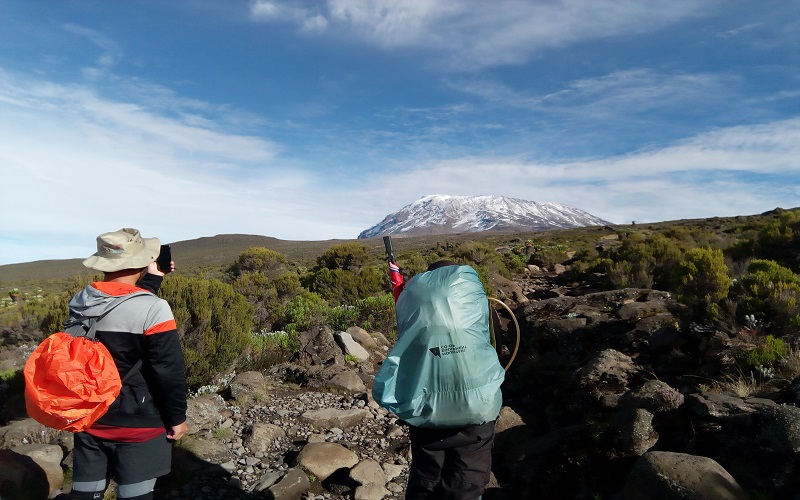🏔️ machame route
Route Name: Machame Route
Duration: 7 Days / 6 Nights on the mountain
Difficulty: Moderate to Challenging
Best Time: January–March, June–October
Accommodation: Camping
📅 Itinerary with Daily Highlights
Day 1: Machame Gate to Machame Camp
- Elevation: 1,640m to 2,835m
- Distance: 11 km | 5–7 hours
- Habitat: Rainforest
Day 2: Machame Camp to Shira Camp
- Elevation: 2,835m to 3,850m
- Distance: 5 km | 4–6 hours
- Habitat: Moorland
Day 3: Shira Camp to Lava Tower to Barranco Camp
- Elevation: 3,850m to 4,630m to 3,976m
- Distance: 10 km | 6–8 hours
- Habitat: Alpine Desert
Day 4: Barranco Camp to Karanga Camp
- Elevation: 3,976m to 3,995m
- Distance: 5 km | 4–5 hours
- Habitat: Alpine Desert
Day 5: Karanga Camp to Barafu Camp
- Elevation: 3,995m to 4,673m
- Distance: 4 km | 4–5 hours
- Habitat: Arctic Desert
Day 6: Barafu Camp to Uhuru Peak to Mweka Camp
- Elevation: 4,673m to 5,895m to 3,100m
- Distance: 17 km | 11–14 hours
- Habitat: Arctic to Rainforest
Day 7: Mweka Camp to Mweka Gate
- Elevation: 3,100m to 1,640m
- Distance: 10 km | 3–4 hours
- Habitat: Rainforest
✅ What's Included
- All park fees and camping permits
- Rescue fees and government taxes
- Professional guides, cooks, and porters
- All meals and drinking water during the climb
- All group camping gear (tents, mats, tables)
- Airport transfers and 2 hotel nights (before/after)
- Pulse oximeter checks and basic first aid kit
❌ What's Not Included
- Flights and Tanzanian Visa
- Travel insurance (mandatory)
- Personal hiking gear (boots, sleeping bag, etc.)
- Tips for guides and porters
- Optional items: portable toilet, oxygen, Wi-Fi
💵 Price Estimate (Per Person)
| Group Size | Price (USD) |
|---|---|
| Solo Climber | $2,100 – $2,500 |
| 2–4 People | $1,900 – $2,200 |
| 5–9 People | $1,700 – $2,000 |
| 10+ People | $1,500 – $1,800 |
❓ Frequently Asked Questions (FAQs)
Do I need previous trekking or climbing experience?
No technical climbing experience is required to climb Mount Kilimanjaro via the Machame Route. However, good physical fitness and prior hiking experience—especially at high altitudes—are highly recommended to increase your chances of a successful summit.
How difficult is the Machame Route?
The Machame Route is considered moderately challenging due to its steep terrain and altitude gain. The trail includes sections like the Barranco Wall and the long summit night, which require endurance and mental preparation. It’s very doable for most fit hikers with determination.
Is altitude sickness a problem?
Yes, altitude sickness (AMS) can affect anyone, regardless of fitness level. The Machame Route follows a “climb high, sleep low” approach, which helps with acclimatization. Guides monitor your health daily, and many trekkers take medication like Diamox (consult your doctor before use).
What kind of food is provided?
All meals are freshly prepared and include hot breakfasts, packed or hot lunches, and hearty dinners. Meals often consist of rice, vegetables, meats, soups, and fruits. Dietary preferences such as vegetarian, vegan, and gluten-free can be accommodated with advance notice.
How cold does it get on Kilimanjaro?
Temperatures can vary drastically. At lower elevations, it can be warm and humid, while at the summit (Uhuru Peak), temperatures can drop as low as -10°C to -20°C (14°F to -4°F), especially during the night. Proper gear is essential for warmth and comfort.
What are the tipping guidelines?
Tipping is expected and greatly appreciated by the mountain crew. Standard tips per climber are approximately $250–$300, shared among the guides, cooks, and porters. Your tour operator will often provide a suggested breakdown to help organize tips fairly.
Is drinking water safe?
Yes. Water is sourced from mountain streams and is boiled and filtered by the crew to ensure it is safe to drink. You should carry a reusable water bottle or hydration bladder and drink 3–4 liters daily to help with acclimatization.
Can I charge my phone or camera during the trek?
There are no charging stations on the mountain. It’s recommended to bring a high-capacity power bank or solar charger. Some outfitters offer portable solar charging systems for an extra fee, but availability may vary.
Is travel insurance required?
Yes, travel insurance is mandatory. Your policy should cover high-altitude trekking up to 6,000 meters and include emergency medical evacuation and trip cancellation/interruption. Proof of insurance may be required before the trek.
What happens if I cannot continue the trek?
If you're unable to continue due to altitude sickness, injury, or exhaustion, a guide or assistant guide will escort you safely down the mountain. Emergency evacuations are available if necessary. This is why comprehensive travel insurance is essential.
Will I have mobile signal or Wi-Fi on the trek?
Mobile reception is limited and unreliable. You may catch a signal at higher altitudes like Shira Camp or Barafu Camp, depending on your carrier. Some companies offer satellite Wi-Fi or phone rental for an extra fee, but don’t depend on it for communication.
